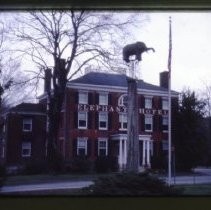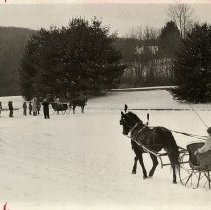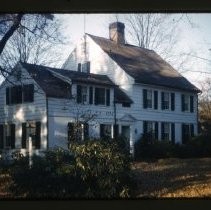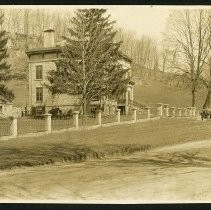This entry includes a walking tour! Take the tour.
Introduction
Text-to-speech Audio
The Somers Hamlet Historic District, in the town of Somers, New York, encompasses approximately 56 acres, and includes 46 contributing and 11 non-contributing buildings, sites, structures, and objects. These varied resources serve as visual reminders of Somers' early development in the years following the Revolutionary War, when two rural transportation routes, including a major regional turnpike, intersected in Somers. The conjunction of these routes brought the area population and business growth. Also on display throughout the hamlet is the image of Old Bet, the “mascot of Somers,” who was the second known African elephant to arrive in North America. She was associated with the menagerie of Hachaliah Bailey, an early advocate for the circus industry and a Somers pioneer. The Somers Hamlet Historic District was placed on the National Register of Historic Places on April 21, 2004.
Images
Elephant Hotel, Somers, NY

Horse and carriage at Heritage Hills

Ebenezer White House

Gerard Crane House / Stone House

Backstory and Context
Text-to-speech Audio
The hamlet of Somers is located in northern Westchester County, New York, in a hilly area that drains into the nearby Croton River. It is home to numerous reservoirs for the New York City water supply system. The resulting protected watershed has played a role in limiting suburban growth in the area and has served to protect some of the hamlet’s Revolutionary War-era and early farming community resources.
Much of the Somers Hamlet Historic District is located along present-day US Route 22, a two-lane highway that follows the path of the earlier Peekskill-Danbury Turnpike, which forks off to dense concentrations of existing historic structures. The Peekskill-Danbury Turnpike together with the old Croton Turnpike, present-day NY Route 100, served to provide passage for both human and animal travelers. The result was the growth of a community of craftsmen, artisans, and laborers to serve the related needs. Homes were built, church congregations were organized, cemeteries were developed, and businesses were born in response, including the creation of a downtown area.
Some of the sites in the Somers Hamlet Historic District include: Old Bet and the Elephant Hotel; Mt. Zion Methodist Church; West Somers Methodist Episcopal Church and Cemetery also known as Tomahawk Chapel; The Stone House/Gerard Crane House; Ivandell Cemetery; St. Luke's Episcopal Church; and St. Joseph's Cemetery. Additional private homes, historic homes converted into businesses, and farms also make up the district.
When the Harlem Railroad arrived in the surrounding communities in the mid-1800s, Somers did not get a station on the line, and its population decreased almost by half from 1840 to 1900. However, this exclusion is one of the reasons Somers still retains much of its nineteenth century historic fabric .
Sources
- "Saint Luke’s Church, Somers, NY: Sesquicentennial Celebration 1835-1985, A History of the Church." St. Luke’s Church, Somers, NY. 1985.
- “Somers Hamlet Historic District #04000349.” National Register of Historic Places. United States Department of the Interior/National Park Service, April 21, 2004. https://catalog.archives.gov/id/75323217
- Somers Historical Society. http://www.somershistoricalsoc.org/
- "Somers, Its People and Places." Published at Somers, NY, by the Somers Historical Society. August 1989.
Westchester County Historical Society
Westchester County Historical Society
Westchester County Historical Society
Westchester County Historical Society
